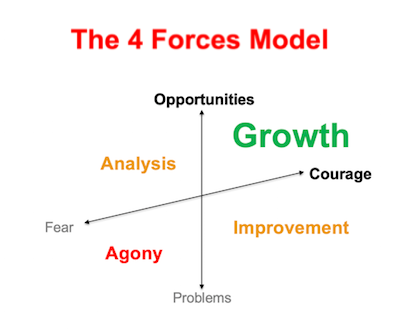Scalability and Elegant Simplicity
On a recent podcast, my good friend Brad Giles and I got into a discussion about the importance of simplicity when it comes to scalability.
We all know the benefits of simplicity. Whether it’s a software program, a map to a destination, or instructions about how to build a piece of furniture for your kid’s room. When things are designed and presented simply, it’s a lot easier to produce what’s expected the first time.
But it’s very challenging to make things simple because businesses, by their nature, are very complex. There’s so much going on - from different customers with unique needs to employees with different operating systems. Never mind the variabilities that may exist in the world.
In a business where you might have hundreds of people doing their own versions of assembly (metaphorically), clear instructions and processes mean you eliminate the possibility of interpretation, errors and headaches. The end result being an increased consistency of results.
Good for the company and less frustration for the person doing the work.
Two Key Ingredients
That said, simplicity that enables scalability isn’t easy to achieve and requires two ingredients: mastery of a skill and time. Without both, you’ll tend to over-design and/or overcomplicate.
We’ve all had experiences watching someone masterful who makes their skill look incredibly easy. Walking a tightrope, returning a blistering tennis serve to the corner of the court, or making the perfect omelette.
When it comes to time, I think of a quote by French mathematician, physicist, inventor, and writer, Blaise Pascal:
“I have made this (letter) longer than usual because I have not had time to make it shorter.”
To write a very succinct, three-sentence email is much harder than writing three paragraphs. Thoughtful editing takes time.
Leaders who are excellent communicators can clearly and quickly make their point versus others who ramble in circles. While they may be energetic and entertaining, you have no idea what their point is.
And when boiling down a company’s vision in a strategic planning session, you can, of course, come up with everything in 20 or 30 minutes. However, writing a vision that is simple, tangible and authentic takes hours, days or months.
When we are so busy doing the work, we don’t take the time to edit and refine and to create that elegant simplicity. Elegance in anything is incredibly simple – but it takes mastery, time and editing. Simple, critical ingredients and steps are required if you want to scale.
You may think you are too busy to take the time to edit and refine something to a level of elegant simplicity but if you want to achieve scalability, it’s well worth the investment.
The Challenge
- What's one important thing in your business that you would you love to simplify – and ideally make dramatically easier for you or your customers?
- Which master (or masters) could you ask to help you to simplify this piece of business and how much time do you think you have?
The Last Quarter of 2020: Review and Reset
Review and Reset What’s Most Important
It’s hard to believe this crazy, historic year is almost over. An incredible amount has changed around us – and perhaps so have some of your priorities.
After the initial shock of COVID-19, most companies found a way to navigate and to function as they had in the past. Others (like those in the tourism sector) have been dramatically impacted and have had a much harder time.
No matter what’s going on, take the opportunity to set aside time to reflect on what’s most important to you, what’s happened so far this year; and to reset and plan. Make your 4th quarter better than the last, using our Quarterly Reset template to review this quarter and plan the next Quarter. It takes less than an hour. Some people find this a great activity to do on their own, some with their spouse, partner or family; and others with a coach or mentor.
And if you find people are reluctant to plan for the next quarter because things in their world are still up in the air, goals can still be set for the day, the week or the month.
No matter what your experience, the key is to have a plan and be ready to adapt, as needed.
The Challenge
- Block 54 minutes get your Quarterly Reset done in whatever way suits you.
- Build your plan for the last 90 days of the year.
And, if you don’t have your full Master Plan for your Work, Self and Life, you can find the template here.
September Reset
September, for me, has always been a second start to the year. People kick off the first, in January, with new focus and passion, and good old resolutions – and September, after time off in the northern hemisphere’s summer, signals a renewed vigour, everywhere.
With that in mind, a September reset is a great opportunity to think about where you want to put that energy, in the rest of the calendar year, and to prepare for your next Quarterly plan (more on that next week).
The Challenge
- From where you stand today, in this very interesting year, what are the most important things to leverage or make the most of during this restart - a mini re-set for 2020?
- What do you need to either complete or initiate this week in terms of your Work, your Self and your Life? (Premise, Your Oxygen Mask First)
Changing Your Mindset From Woe to Wow
“Everything negative - pressure, challenges - is all an opportunity for me to rise.” - Kobe Bryant, MVP award-winning, Olympic gold medallist basketball player
Being an entrepreneur or a leader of an entrepreneurial company is one of the greatest adventures you can have in your lifetime. It is challenging and rewarding like almost nothing else I’m aware of.
And whether leaders are attracted to the adventure, or the stress that comes with it, many pay a very high mental price.
We’re often wired to believe we need to handle things on our own. But when they become too intense or scarring, we really need professional help like that of a psychologist or counsellor (Yes, you too!). Think of it like the difference between a sprained toe and compound fracture of your leg – different injuries needs different sorts of help – and the same is true for stressful situations. Sometimes we need expert help to get us through.
At least once or twice a week, I’m involved in a conversation with (or about) someone who is truly suffering from the stress and pressure of the challenges they’ve taken on. And one of the biggest things I work with CEOs and leaders on is their mental resilience and emotional resilience - how they can learn to handle bigger and more stressful challenges, without crumbling under the pressure.
This is one of the most important skill sets for highly driven leaders to learn - because they’ll never stop taking on the challenges.
"Whatever doesn't kill you simply makes you stronger." - Nietzsche, 1888
Besides taking good care of yourself (with exercise, sleep, nutrition, doing fun things with friends and family), the most important strategy is how you look at these challenges. Simply changing your mindset can turn stressful challenges into learning opportunities that make you stronger.
In Your Oxygen Mask First I share a principle called ‘Woe to Wow’, which I believe is the most important shift people need to make.
You can look at these experiences through one of two lenses:
The ‘Woe’ is me mindset.
“OMG, this is horrible…someone or something is making me miserable…it’s not right…it’s not fair!”
This is very much a victim mindset. You see yourself as a victim of the situation, and hope that someone will save you, and take the problem away.
It’s passive. It’s a recipe for disaster. All you’ll do is sit there, feel crappy, and do nothing.
The ‘Wow’ mindset.
“This is crazy! I’m being tested, and stretched. I have no idea how to solve it, but I know if do, I’ll be way smarter on other side.”
This is a resilient mindset. It’s action oriented. And you may need some outside help - like a coach, a partner, or a board member – to get there.
Changing Your Mindset
So how do you make the shift? (Unfortunately I don’t believe everyone can because some people are so committed to being a victim, they can’t get out of it – at least on their own.)
See the gift within the curse.
Look for what good will come from this - that, at the very least, it’s an amazing character- or resilience-building experience for you.
Take action.
Do what you can to move ahead instead of waiting for someone else to solve the problem.
And that includes getting help.
Look back and learn.
Once you’ve worked your way through, make sure you figure out the learning from the experience, and how it made you better and stronger.
Wisdom comes from getting your butt kicked – hundreds of times.
Remember: You can’t avoid crazy, stressful situations - they are going to happen. It’s why a lot of people hit a stride in their 40s and 50s: they’ve learned so much along the way.
When my clients are challenged, I often get giddy, and break into joyous laughter - because I know they are going to make it through, and I get excited about their learning and growth.
So while not of our choosing, these situations are wonderful gifts - to be loved for the teachers they are. You don’t learn anything deeper, or build character, intelligence, resilience or confidence when things go well.
These only come from changing your mindset and fighting your way out.
“The deciding factor in life is how you handle setbacks and challenges. People with a growth mindset welcome setbacks with open arms.” - Travis Bradberry, author Emotional Intelligence 2.0
The Flywheel Effect - Is it Working For or Against You?
Over the past five years, one of the most powerful strategic tools we’ve implemented with clients is the Flywheel (Initially created by Jim Collins in his book Good to Great and in his follow-up Turning the Flywheel: A Monograph to Accompany Good to Great). And while we’ve always known and talked about the metaphor for building a business, it wasn’t until we had a group of CEOs, with Jim, in his lab in Boulder, Colorado that I got the full depth and understanding of how to identify and build a Flywheel for a business, and how to use it as a growth engine.
Many are familiar with the Flywheel effect - building momentum to become more powerful, unstoppable force - much like a cartoon snowball that rolls down a hill, getting bigger and bigger and bigger as it gets closer to the bottom.
With a Flywheel, that snowball rolls down an Infinite hill, with an infinite supply of snow and infinite growth potential – almost to the point where the snowball becomes the size of a galaxy, over a decade or two.
So, it’s an incredibly powerful tool - and generally hard to figure out and get right. Some Flywheels apply to a business overall, some to each individual locations a business may have.
Now that we’ve developed and used the Flywheel with dozens of clients, I truly see the essence of the power and sustainability of a business’s growth because it’s really about the knock-on effect of how one good deed leads to another and another and another to become a virtual circle. When you get it right, it not only clarifies your strategy for growing your business, it crystallizes and aligns your team around what truly matters the most.
The Flywheel Effect as a Health Check
Once in place, the Flywheel can also be a health check for the company, to really see where it’s performing and where it isn’t. If you get the Flywheel right, there’s a direct correlation between the health of the Flywheel and the health of the business. Here are two examples:
- Just over six months ago, back when I could travel, I was working with a client in the US with whom we had built and acid-tested their Flywheel from different perspectives. We had nailed the essence, and the company had been building over more than two decades.
A piece of the business wasn’t performing as well as we wanted and, by looking the Flywheel, we went through each of the key drivers and rated their strength from 0-10. We also evaluated how resources had been allocated and had a massive epiphany when we realized we had under-resourced and put the fewest new hires in the weakest link on the Flywheel. Over the years, we had taken that weakest link and put on even more pressure.
After going through this process, it became crystal-clear what we had to do to increase and improve performance, which translated into our goals for the coming year.
- For another company, we used the Flywheel to inform an acquisition strategy. When they took the company to market, we used it to explain to the buyer why the business had grown so profitably and rapidly – and would continue to do so, if we kept feeding the Flywheel. The buyer easily understood and could be more confident in the future of the business.
While there are hundreds of different things that make a business tick, when you boil it down to a Flywheel, you can see how your business can be more powerful and effective.
It’s worth the work to figure out your Flywheel and make it part of your quarterly rhythm to evaluate performance - and to guide where you set priorities and allocate resources to make sure you strengthen the key aspects of your business and don’t inadvertently starve other areas where they need resources the most.
The Challenge
- If you haven’t defined your Flywheel yet, how are you going to make sure you and your senior team clearly understand and align to all your strategic and capital decisions?
- If you have done it, pull it out, see if you need to change anything based on your new understanding of the market, now, what are you going to do to make it part of your review on a quarterly basis?
If you need help in understanding or designing your Flywheel - or educating your teams about how to use it effectively, just let our experienced team know.
Growing a Business vs Business Administration
I recently had a conversation with an entrepreneur who was enjoying great success in his first two years of business, and very excited about future growth opportunities.
When asked for my perspective and advice, I shared some of the experiences I’ve had through amazing clients, over the years – some do’s and don’ts, and big mistakes – including running a business instead of growing a business. This usually happens for two reasons:
- Always being on the front lines, dealing with customer needs, concerns and frustrations can be exhausting. If a CEO has been focused there for 5, 10 or 15 years, stepping back can be a break
- Creating order from chaos can consume you because there’s so much other stuff to do. You can easily stay busy forever with projects, cleaning up systems and planning for the future.
The challenge is to be OK with a small amount of messiness so that you can continue to dedicate the energy needed to grow the business. If you put too much energy into optimizing or administering, growth normally slows down. As in the 4 Forces of Growth model I recently shared, you can either be in the Improvement quadrant or the Growth quadrant – and you have to fight to stay in the Growth quadrant.

So, what does that look like? It looks like the leader of the business spending time talking to and getting feedback from customers and people in the market (vendors, partners or potential partners) to get sense of where market is going - and the insight to deliver additional products or services, or to modify existing ones, to make sure you’re doing a good job of meeting your customer needs in a way that’s more competitive.
Some prime examples:
- A CEO we work with recently was thrilled to say they had been doing well over the past few months and wanted to know what was driving this new business. As they dug deeper to really understand, they found that the transactions were with customers who were different from usual – and realized that, if a new customer was buying today, they could ask a bunch of new, proactive questions to find out more, and potentially change their approach to business.
- Another CEO called me a few years back when growth had stopped. As I dug in to understand why, in a booming economy, I noticed that, although they had a great system for customer feedback, no one was reading or responding to it. On the way out of the door, I asked for a copy of the feedback to read on the way home and was shocked to hear how angry the customers were on three consistent issues. No one was paying attention, the issues weren’t getting addressed and the company was frustrating and losing customers. People were voting with their dollars.
Management on the Front Lines
This reminds me of the well-known term “Management by Walking Around” (from in Search of Excellence by Tom Peters and Robert H. Waterman Jr.) - to which I’ll add “Management by being on the front lines so that you can really understand what’s going on from the perspective of customers, competitors and the market.”
Yes, there’s a whole bunch of things to approve and administer in a business but you want to make sure you don’t get lost in it - and keep enough energy on things that matter and keep your business growing.
The Challenge
- How appropriate is your ratio of how you spend your time between growing and improving or running your business?
- Based on your aspirations, how might it change?





